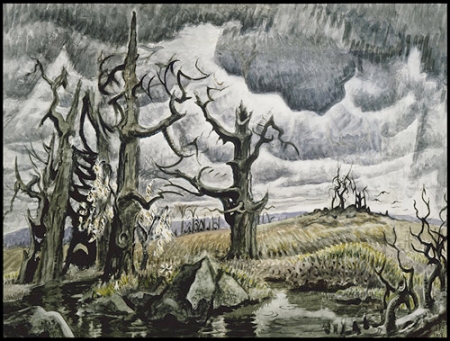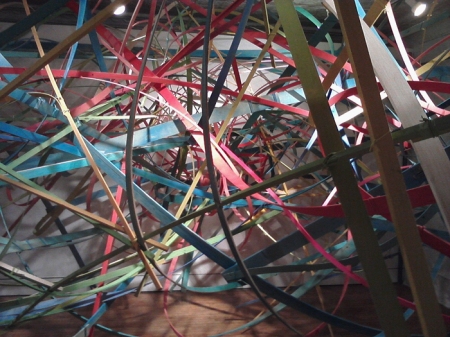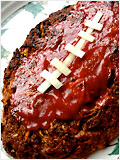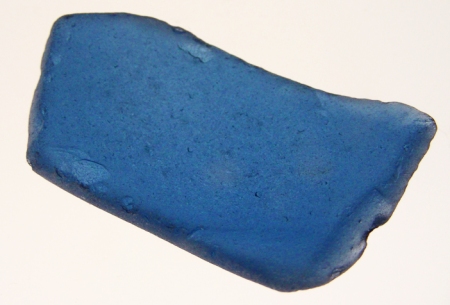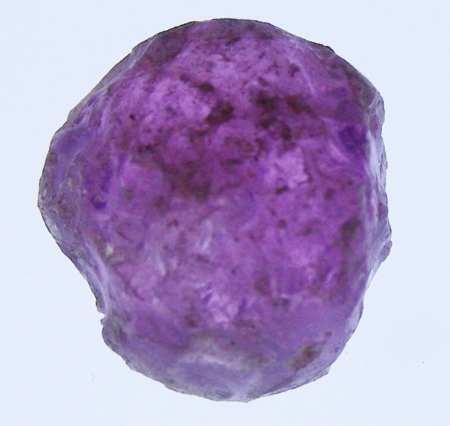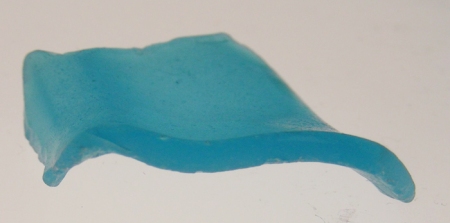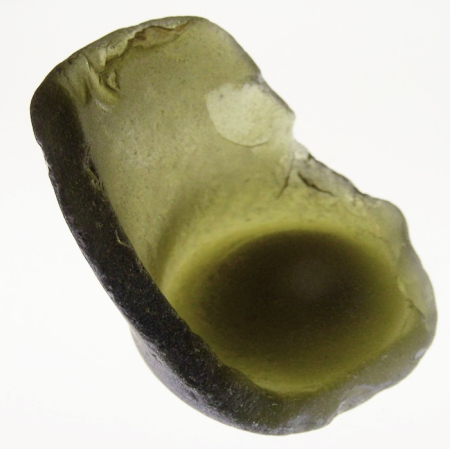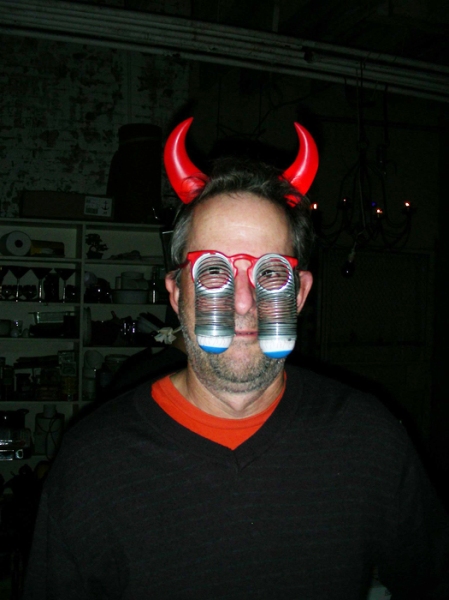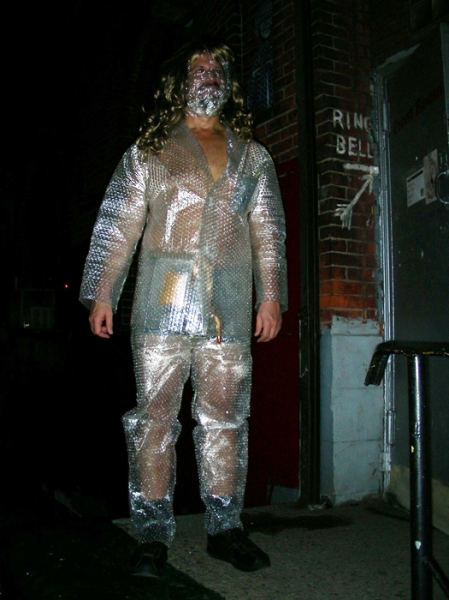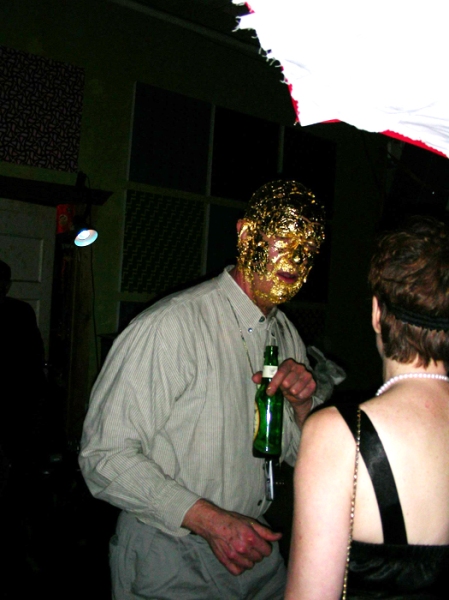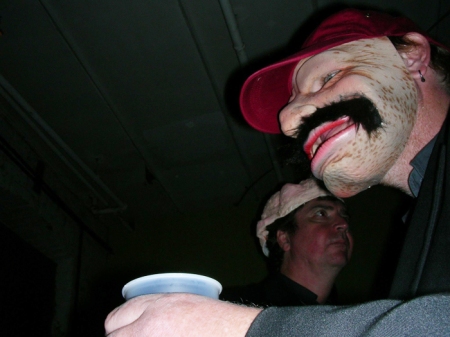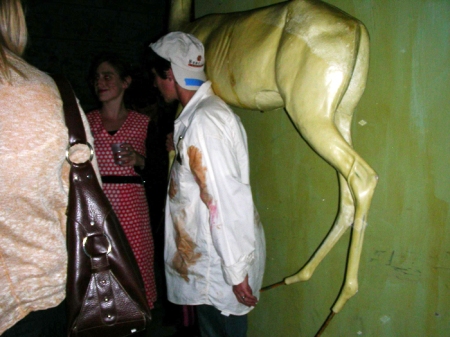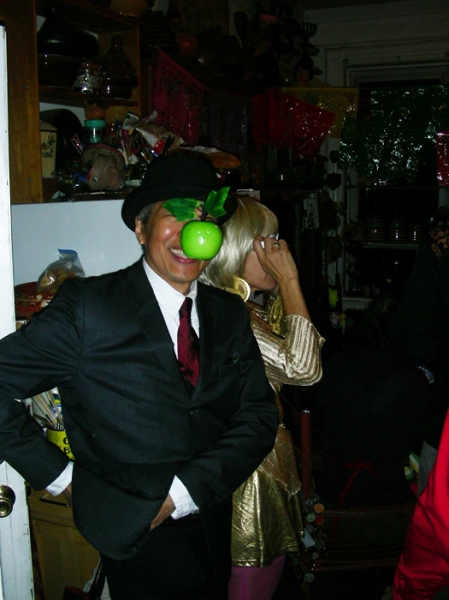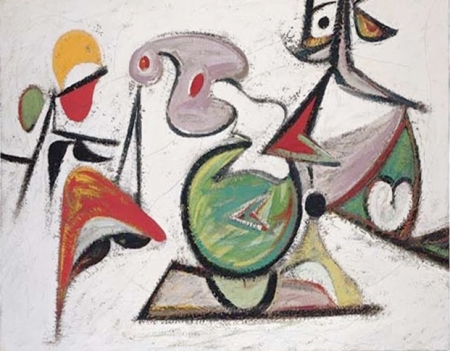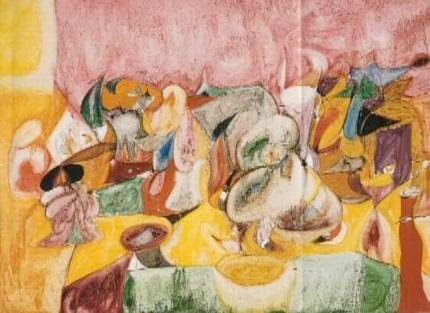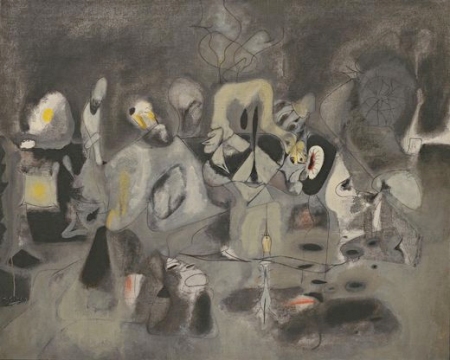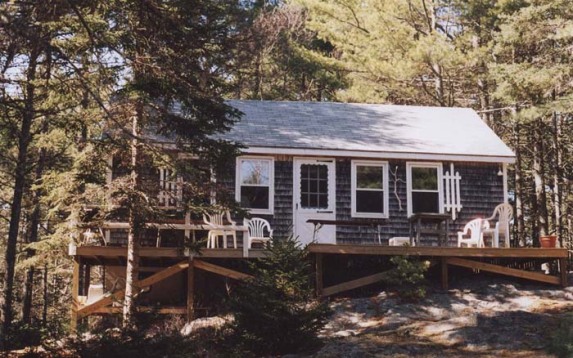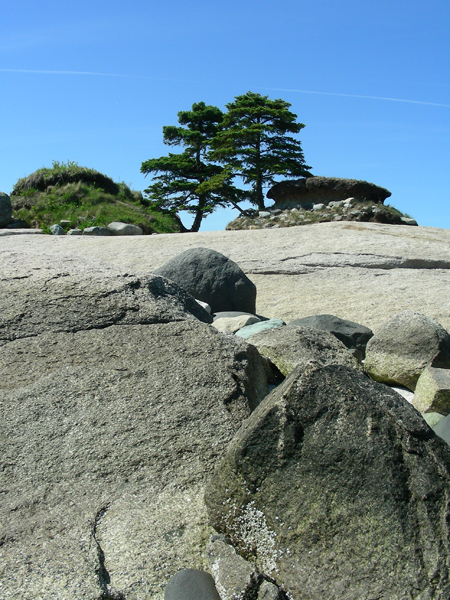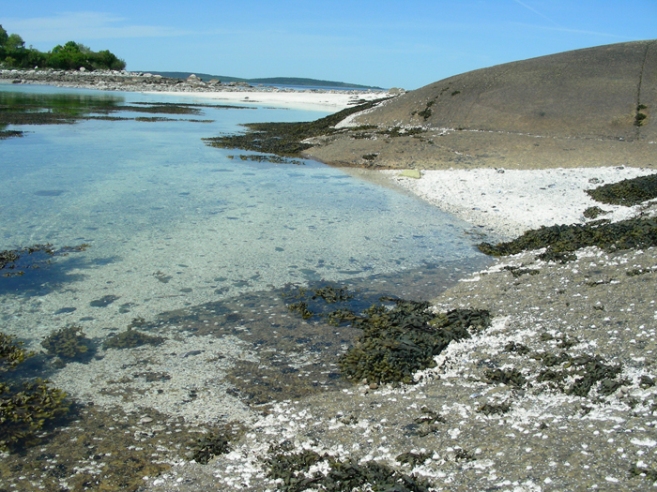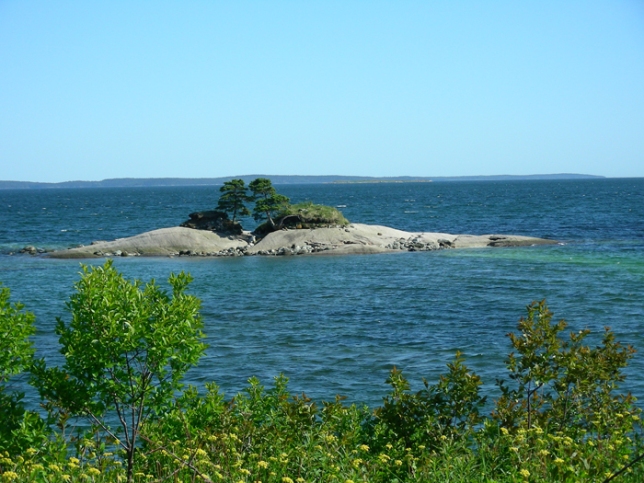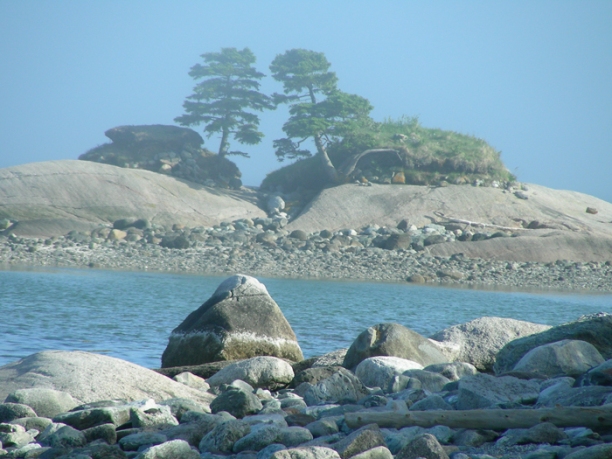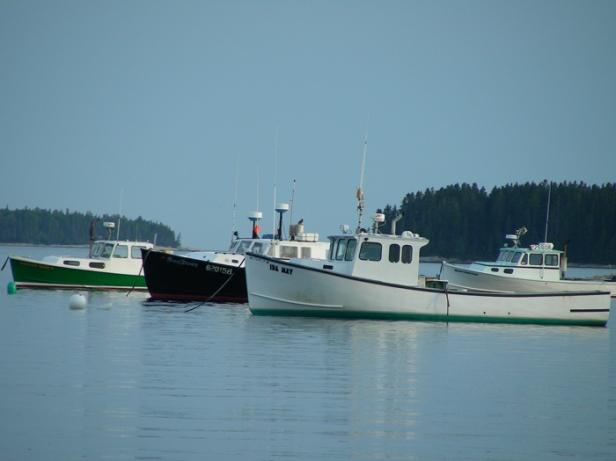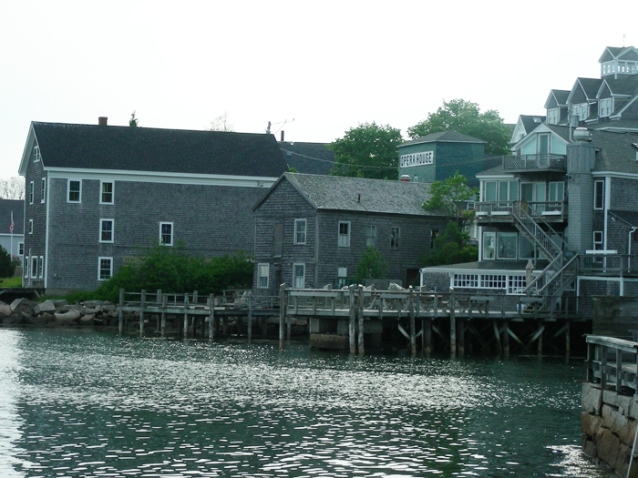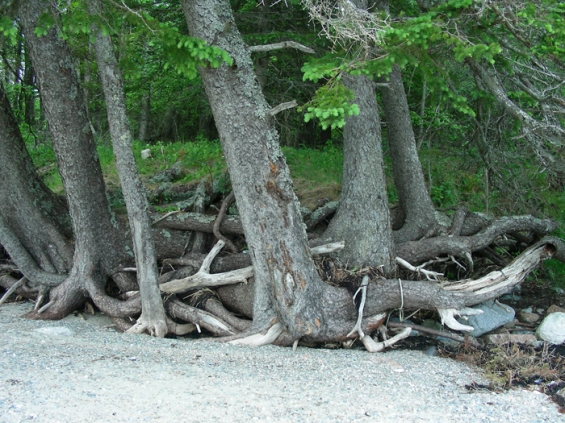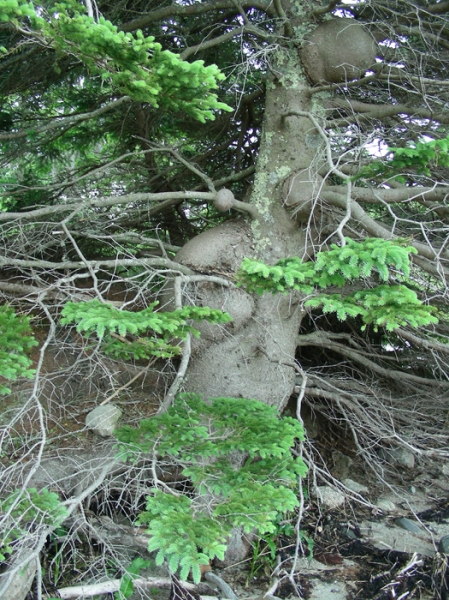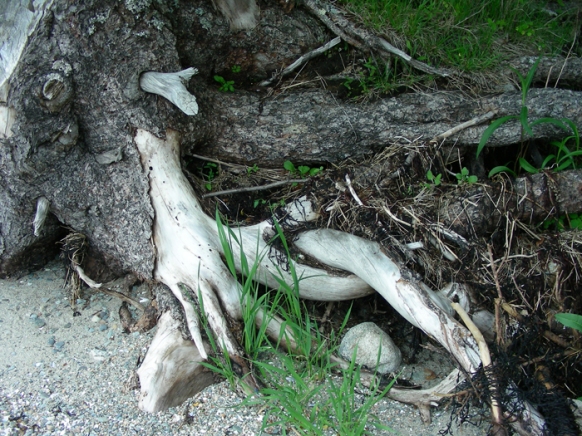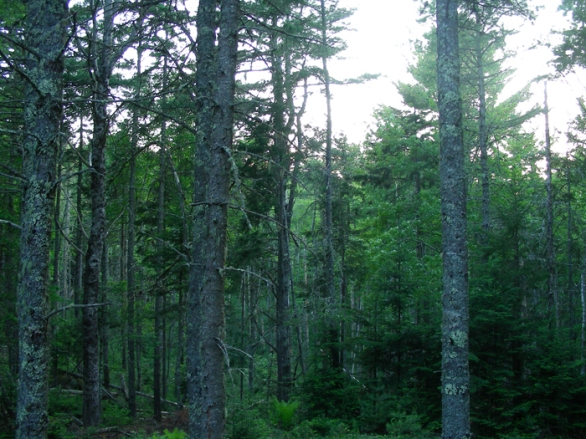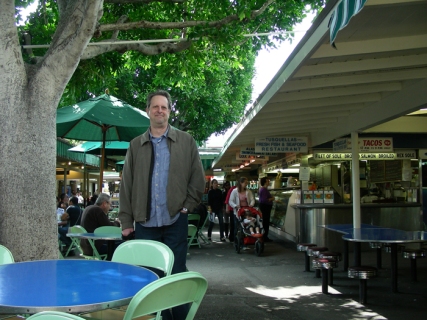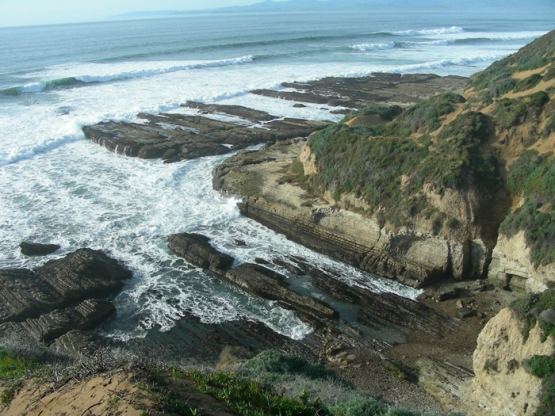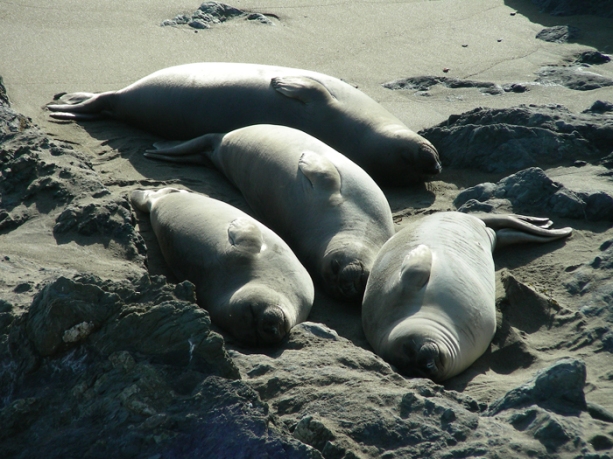Fri 3/12
Arrived LAX 1:45 PM PST .
Picked up red Hyundai Elantra, got on the 405 to Wilshire (welcome to Beverly Hills), onto Santa Monica Blvd into WeHo (West Hollywood).
Pulled up to Le Montrose, our cute little boutique hotel nestled into a quiet, formerly (1970’s) bohemian neighborhood near the Sunset Strip (Whiskey a Go-Go is right around the corner). The place tends to cater to minor exec’s in the biz, but Expedia had a great deal there.
The rooftop pool and deck was great for a power breakfast, or a late night Jacuzzi (passé?).

Cool pool on Le Montrose roof.

I was immediately sold on cruising around LA, that big sunny cerulean sky beaming down on all those left turn bays, excellent! Local streets are wide and much easier to navigate than here in the Crammed Apple, u-turns are a breeze. (just after I hung a quick u-turn in the middle of Sunset Blvd at about 10 PM to park, the valet pointed out the LAPD cruiser eyeballing me. Didn’t get pinched) The sheer volume of traffic is stunning, but so is the runway-like expanse of the freeways. Sure there was plenty of “pauk jaumed” traffic (as they say in Flatbush), but theres always a nice view of the snow capped San Gabriel’s.
It dawned on me that its likely that west coast limited access highways are referred to with a “the” in front because they are a destination unto themselves. Its like going to “the” bank, or to “the” bathroom, a goal oriented activity that provides a tangible result, in this case joining the mass pilgrimage to wherever everyones going. Its all about lifestyle.
My man in LA, Mark Sprecher (who hates to drive, but still manages to love LA somehow) and his spouse Paul suggested we all meet that evening at Pizzeria Mozzo, Mario Batali’s left coast bastion of succulence over on Montrose. I’d managed to snag a reservation several weeks in advance, and a good thing I did. This was one of the culinary highlights of our trip.
You have to start with their antipasti which are really more like tapas. The bone marrow
al forno is a gooey delight served inside large (maybe 2” diameter), piping hot bones, alongside a garlicky relish with toast on a bed of greens. This dish may not be for the finicky, but those with a slightly adventurous palette will be rewarded handsomely.
Also not to be missed are the fried squash blossoms with
ricotta, A number-one, and the Cauliflower
gratinate.
My favorite pizza was the Bacon, salami, fennel sausage,
guanciale, tomato & mozzarella, to die for.
The olive oil gelato for dessert must be the reason mouths were invented. Just a slight tang of salt smoothed over by the chilled, silky sweet goodness of the fruity olive essence.
http://www.mozza-la.com/pizzeria/about.cfmSat 3/13
The Farmer’s Market in LA is more of an institution than a happening. Around since the 1930’s and set up as a grid of permanent semi-enclosed booths and shops, it’s a 7-day a week scene with its own off-street parking lot.
We started with breakfast at Du-Par’s a local on-site brunch legend featuring copious servings of comfortable and yummy food. We rambled around afterward taking in all the SoCal ambiance.
My favorite haunt was the hot sauce shop with the spicy labels.
http://www.farmersmarketla.com/history/index.html
Jeanne’s art opening at Jancar Gallery was later that evening. She had created a group of crocheted sculpture just for this show. The gallery is in Chinatown, located on the Chung King pedestrian mall. For reasons unknown to me this little corner of LA now hosts the rough equivalent of an odd sort of left bank. There are about 4 or 5 gallery spaces clustered among dingy Chinese restaurants and gift shops.
Fortunately Tom Jancar has the nicest, largest exhibition space and we were quite pleased with how Jeanne’s work was hung. (Although Jeanne took pains to send plenty of photo documentation of how the pieces were to be oriented, one of them was upside down. In typical Tremel fashion she quickly got it right side up with out anyone noticing)
Mery Lynn McCorkle an old friend of Jeanne’s from Williamsburg had curated the downstairs project room exhibitions for several years, but this was her last effort in that regard. Mery Lynn had a solo exhibit upstairs in the main gallery opening the same night, so we had a nice reunion at the gallery.
http://www.jancargallery.com/
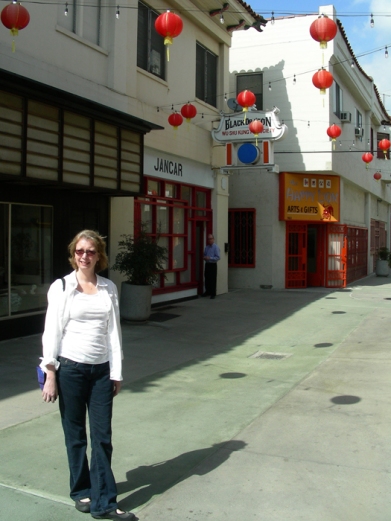
Jeanne in front of Jancar Gallery, Tom Jancar in background (before we had introduced ourselves and he knew who we were)

Mery Lynn and Jeanne upstairs in the main gallery.

Jeanne's work in the project room during the opening.
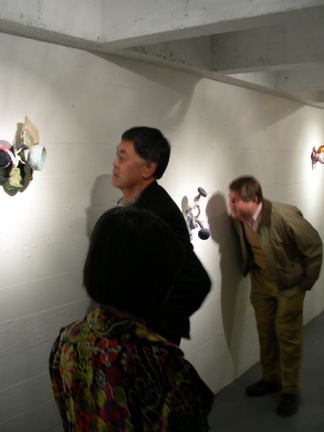
Mark Sprecher (back, right) inspecting art.
Sun 3/14
Off to the Getty after room service brought our breakfast up to the roof deck, spoiled rotten!
Even though the Getty epitomizes the ostentatious, big money museum with over sized architectural ambitions, somehow the grandiose scale humanizes itself. The place is like a Greek temple, paying homage to the art gods, but receptive, even welcoming to the peasant folk. I overheard a docent mention that a scene from a “Star Wars” movie was shot on one of the balconies, how populist can you get!?
The gardens and open air feel are inviting and take the edge off museum overcrowding, and they actually allow photography of the permanent collection.
Jeanne knew they had an important James Ensor painting we really wanted to see, Christ’s Entry into Brussels. There it was in all its macabre glory, it hadn’t been included in the terrific MOMA exhibit last year, so it was great to get to stand in front of it, up close and personal.
http://www.getty.edu/art/gettyguide/artObjectDetails?artobj=932
There was also a brilliant Courbet that I’d never seen called Grotto of Sarrazine near Nans-sous-Sainte-Anne:
http://www.getty.edu/art/acquisitions/courbet.html

View approaching Getty from air cushioned tram.
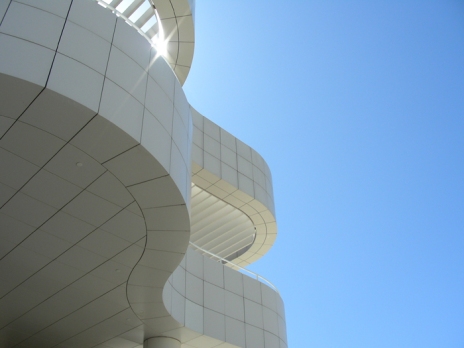
Architectural detail at Getty.
Our next stop was Venice Beach and Jeanne’s first foray onto the wet sand of the great western ocean.
But first the Muscle Beach boardwalk. The Venice Beach neighborhood hadn’t changed much since I’d first visited in the mid 80’s except that perhaps there weren’t so many roller blades. The dependably funky crowd of creeps, cretins, and curmudgeons made for an entertaining afternoon of gawking.
We had arranged to meet Miriam, an old friend of Jeanne’s who had been at her opening the night before. She brought her 2 pre-teen kids who were having a great time blowing their allowance on trinkets and doodads. I wish I’d had as fun a place to go when I was 9 or 10.
We watched the sun plunk down under the horizon headed toward Japan.

The Venice Canal.

Statue Man with his fake dog.

'nuf said.

Miriam's kids learning fiscal restraint.

Sand sculpture.

Hellooo, Pacific!
Mon 3/15
About 4 AM I am awakened by a loud creaking noise that at first I think is someone trying to get the door to our room open. Then the bed starts shaking noticeably, I’m ready to rouse Jeanne, but suddenly its over. A paltry 4.6, the morning news programs are giddy with man-in-the-street stuff and making sure that you know you should have a loud whistle in your earthquake survival kit in case you’re buried in rubble. (wonder if they’re passing out whistles in Port au Prince now).
Made our way over to BLD (Breakfast Lunch Dinner) for brunch. Best known for their blueberry ricotta pancakes, and that is of course what I had. Quite a treat! By about 10 AM it was already in the upper 70’s so we sat out in the shaded sidewalk café when Jeanne spotted the famed “Hollywood” sign. Nice LA moment.
Our main event today was a trip to see the Watts Towers. I’d never heard of them but fortunately Jeanne was reminded after spotting a blurb in “Where” (a local LA glossy ala New York Magazine).
Built by an immigrant Italian bricklayer over 30 years between the 1930’s to the 1950’s they rise up incongruously over the low-lying neighborhood, an homage to the obsessive-compulsive nature of great outsider art.
http://www.wattstowers.us/
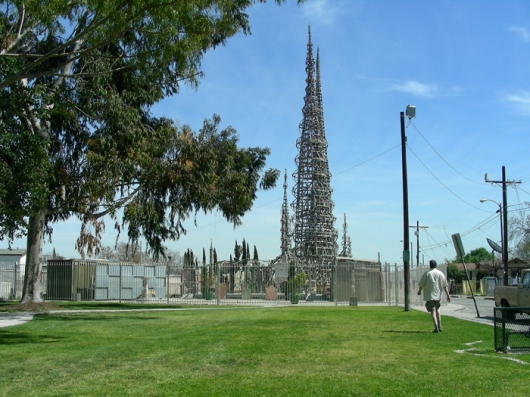

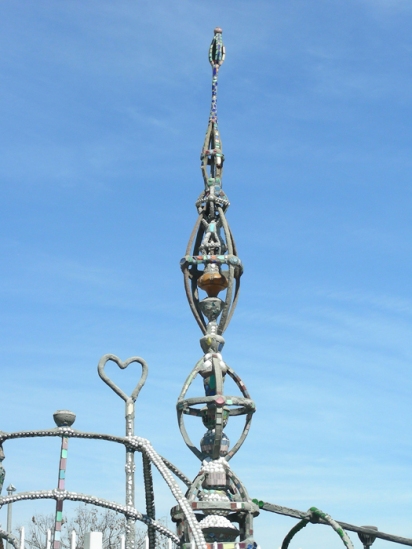

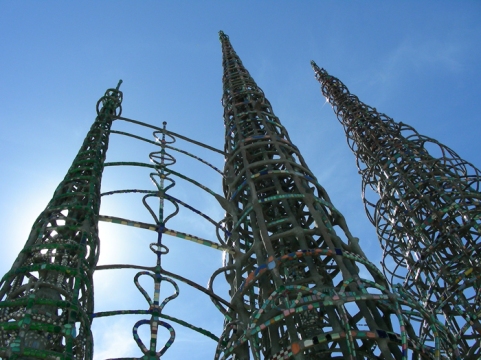
Next we got on the 405 for a cruise up to Mulholland Drive to check out the Hollywood Hills. Mulholland runs east-west across a ridge top over looking the Los Angeles basin. All the super exclusive homes are east of the 405, so I decided to head west where Mulholland seemed to just peter out on the map.
After a short drive the road did indeed become really narrow and steep, and then became unpaved and unnamed as it wound its way up precipitous mountain switchbacks. Jeanne was getting a little nervous, this would not have been a good place to get stuck, but we finally rounded a curve and came out to a grand vista where the road ended.
The place was called San Vincente Mountain, and there turned out to be an old Nike missile base just a short walk up above. It had become a hot afternoon and even though we were close to 2000 feet above sea level the air was still and the sun was beating down. But everything was green, verdant and fragrant after all the late winter rains. A bluebird wafting over a rugged ravine snatched a bug with its beak in mid air.

- View towards Venice Beach from San Vincente Mountain.

- Our rental car in foreground, Simi Valley in the background.

Tue 3/16
LA was in the rear view mirror as we headed north for a couple of nights in the central coast region.
We took the Pacific Coast Highway out of Malibu hugging the coast for the first hour or so. What a great road, twisting and turning its way through various inlets and bays with spectacular ocean vistas and beckoning beaches. The route then heads inland, passing through sprawling fields of cultivated strawberries, finally coming out to the 101 in Oxnard.
We stepped on the gas and flew low up through the sometimes craggy, sometimes gently rolling and grassy hills north of Santa Barbara. Jeanne really needed some quality beach time so we had to get to Los Osos ASAP.
The town of Los Osos is just south of Morro Bay, it’s a quiet and unremarkable little hamlet, but if you continue west for a few miles you enter the Montaná de Oro State Park which is quite remarkable. This CA state park is a lesser known locale than Big Sur but features spectacular and pristine bluffs and beaches equal to Big Sur. The most accessible beach is called Spooner’s Cove where we spent the rest of the afternoon.
We had a very unique wildlife experience at Spooner’s Cove. I had been up on a bluff taking pictures and when I came back down I found Jeanne with a small group of people surrounding what turned out to be a baby Elephant seal. This pathetic looking creature had obviously been separated from its mother and tossed on the beach by the strong surf. (I was amazed by the size of the breakers, some of which had to be cresting at 15 feet) Jeanne had watched it make its way up the beach toward the base of a bluff where it now lay flipping sand on its back with it’s flipper.
I got in the car and found a spot up above the beach where I could get cell phone reception and called 911. The operator seemed concerned and patched me through to CA Fish & Game who got a park ranger to the scene in less than 5 minutes. He immediately made everyone get at least 20 feet away from the critter, and you could see it relax and doze off. He explained that that seals tend to get agitated around people and that this infant was under-nourished to begin with.
The plan was for Fish & Game to arrive within a few hours and transport the seal to a facility in Monterey that would nurse the seal back to good health and then release it. Apparently this kind of thing happens on a regular basis and since Elephant seals are a protected species they get this kind of care.
We didn’t wait around, but hopefully this had a happy ending.

- Pacific Coast Highway.

- View of Morrow Bay in distance from Montaná de Oro State Park.

- View of Spooner’s Cove.

- Bluffs at Montaná de Oro State Park.

- Spooner’s Cove.
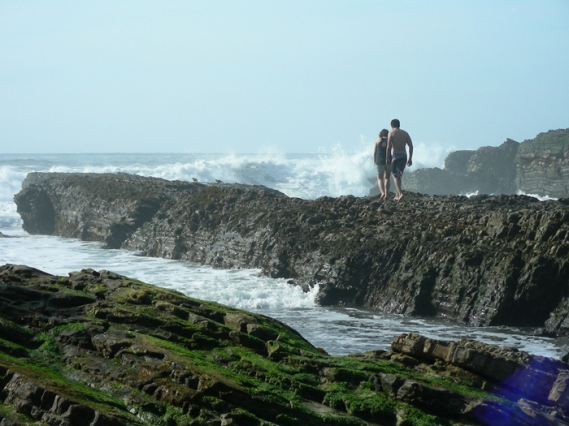
- As far as I know they survived.
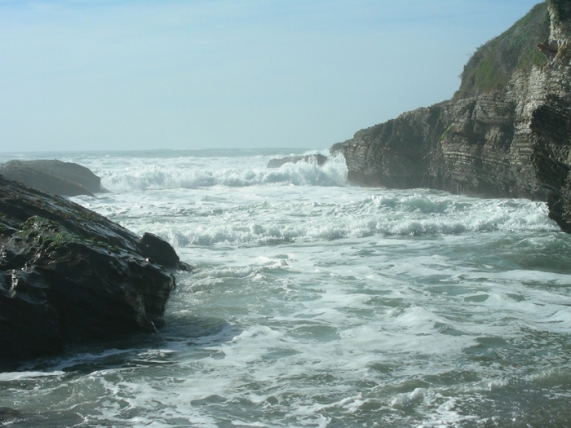
- Rocks and surf at Spooner’s Cove.
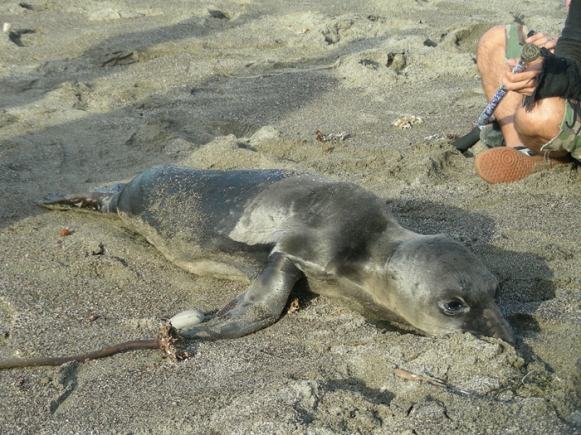
- Baby Elephant seal at Spooner’s Cove.
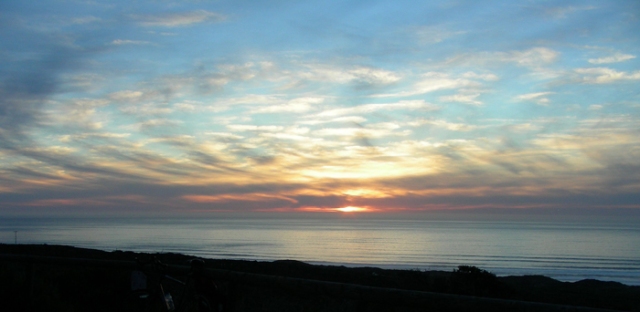
- Sunset Montaná de Oro State Park.
Wed 3/17
After spending the night in Morro Bay in a modest but cozy little motel (theres nothing fancy for food or lodging in Morrow Bay, the previous evening we had walked in the door for dinner of the busiest establishment in town just before they were getting ready to close at 8 PM. We had to eat in a hurry), the next morning we headed over to Morro Rock for more beach time.
This awesome mound of rock towering over 500 feet juts out of the bay, dominating the scenery. It’s a 21 million year old volcanic plug that was used as a quarry until 1969, its now a bird sanctuary.

- View of Morro Rock from town.

- Detail, Morro Rock


We had busy day in store; a short trip inland to Paso Robles for an early lunch reservation at Artisan, one of the premier dining establishments in California, and then a 3 PM tour at the Hearst Castle.
Artisan is anchored to the nearby central coast wineries and farms, and serves a truly inspired and creative menu based on those riches. The room itself is relatively spare, a lot of comfortably spacious, dark mahogany looking banquets and chairs that are offset by large windows looking out onto the broad streets of downtown Paso Robles.
We started with the “Local Elite Flight” which included a spectacularly good single vineyard blend; the Booker Syrah/Cab Sauvignon/Cab Franc/Petit Verdot “Remnant”, ’05, produced, as our waitress slyly informed us by an “old hippie” type. Well done long hair.
The cheese plate was entirely sublime, the flavors morphing and melding as the fromage acclimated to room temperature. I couldn’t resist the Hearst Ranch Grass Fed Flatiron Steak, with Fries, shallots, and cabernet butter slathered on top, but I had to apologize later in the day to its kin over in San Simeon.
http://www.artisanpasorobles.com/restaurant-paso-robles-artisan.php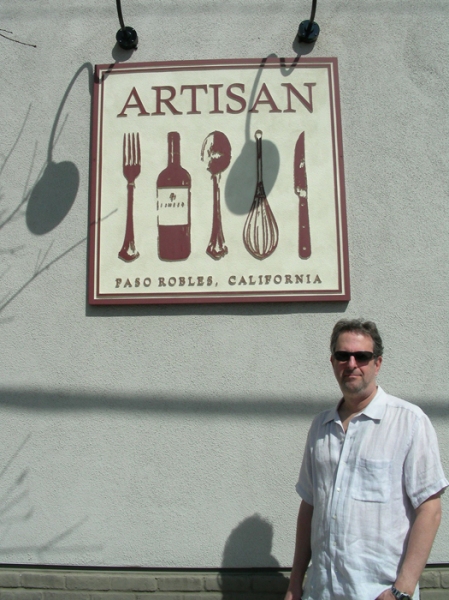

- Wine & cheese at Artisan.

- Wine country in between Paso Robles and San Simeon.

- Farmland near San Simeon.
The Hearst Castle tour is not to be missed, it gives a compelling feel for the mystique of an opulent era. The place reeks of myth, its like walking into a theater piece or an epic Victorian history novel. Curiously, I never envisioned Orson Welles per se, but the Hearst legacy permeates this cathedral-like aerie. Near the end of the tour you get to sit in the original screening room/movie theater and view clips of the likes of Charlie Chaplin cavorting on the tennis courts. A solemn and cranky looking W R Hearst presides over all.

- The approach to Hearst Castle.

- On the grounds.

- Douglass Fairbanks loved this pool. It’s still used by park service employees.

- The Hearst property line extended past the most distant mountains in the background.

- A guest room.
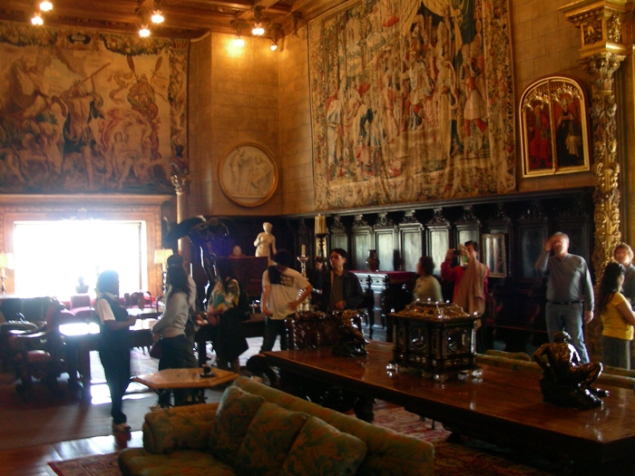
- The main reception hall.

- The indoor pool beneath the tennis courts.

- Although now unheated this pool can still be used.
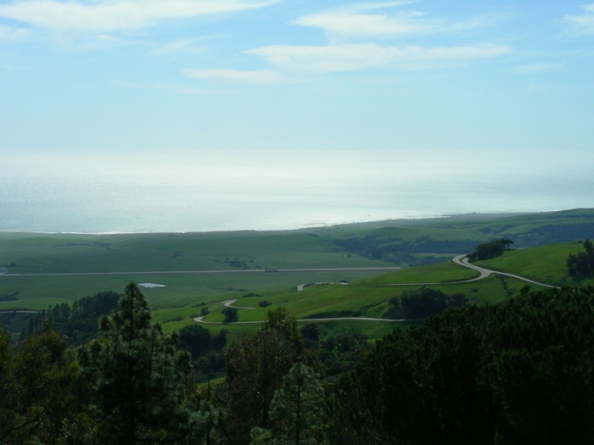
- View down the mountain of the Pacific.
Our last adventure today was to visit the Elephant Seal rookery at Piedras Blancas, just a mile or so up the road from the Hearst Castle visitors center. We’d heard about this place from the ranger who we’d met at Spooner’s Cove, but it’s a fairly well known place anyway.
http://elephantseal.org/

- A big male and some juvies.
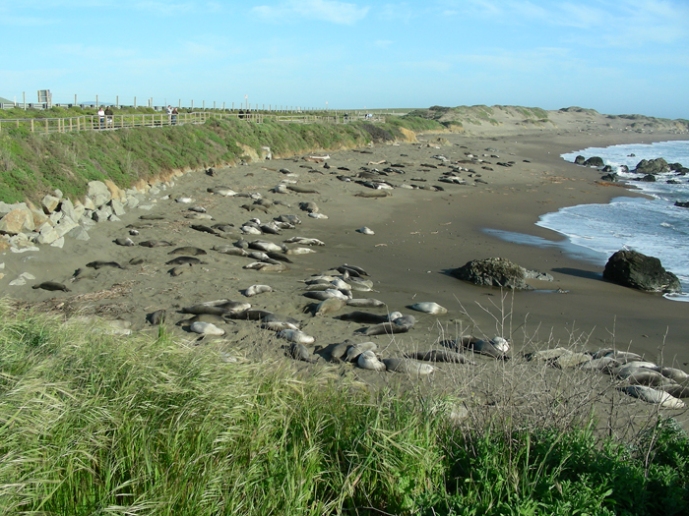
- Sometime they seem like big, dead piles of blubber until they start to squack.
The next day we headed back to LA after a brief stop in Santa Barbara for lunch with Mark Sprecher’s sister Anne. We got together at a little Mexican place called Super Rica which is actually quite famous for its causal approach to some of the best Mexican delicacies north of the border.
A must do when in Santa Barbara!
We were spending our last night at Mark Sprecher’s house in the Los Feliz neighborhood just under the Griffith Park Observatory.
Mark and I go all the way back to the mid 70’s when he was living in NY. I was a short order cook at this joint near NYU and Mark was trying his hand as a waiter. We both decided after a lesson from the boss “Big Al” in how to make pubic hair scrambled eggs (dig your hand deep into your crotch for a good itch before breaking eggs) that perhaps we should move onto bigger and better things.
Mark has been a generous patron of my art over the years and certainly has the largest (and only) collection of my paintings west of the Mississippi. Since I hadn’t visited LA in 10 years it was nice to see my work and the rest of his terrific collection again.
Mark and his partner Paul put out a lavish feast of Indian food. (Mark is an accomplished chef having traveled extensively in South Asia and trained at one of the best culinary schools in Thailand)
It was great way to wind up a fantastic trip while bringing back a tan to ward off the grim reality of New York in March.

- Jeanne at Mark’s front door.

- Fairytale neighborhood.

- View of LA from the backyard.
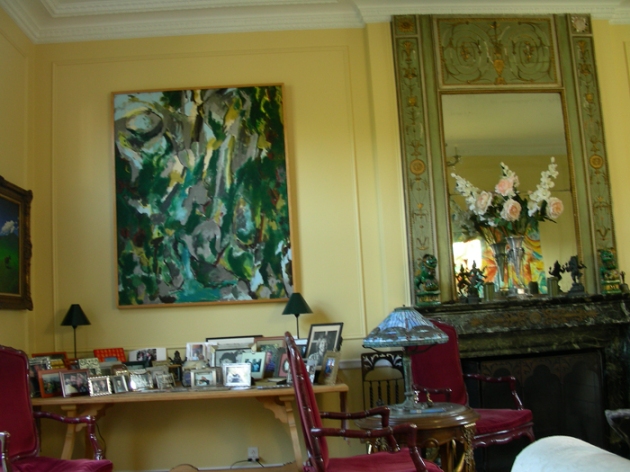
- My painting “Bash Bish Falls” from the mid 90′s in the living room. You can just make out the reflection of another painting of mine in the mirror.

- Mark takes a break from the kitchen, Phillip in the background with his, well you know what…
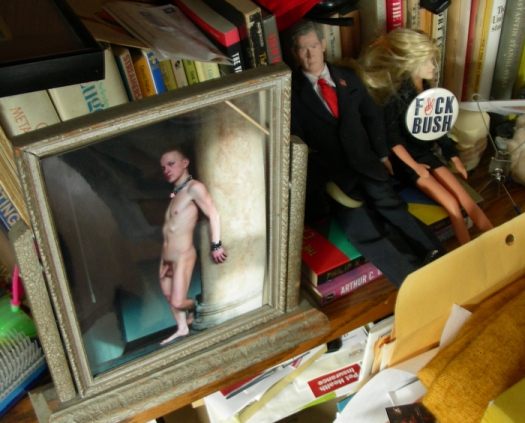
- How ’bout a little lefty homo-ertoica to wind things up? My cousins will love this!








